| Author |
Message |
Merv Cannon

|
 Posted: Wed 01 Mar, 2006 12:31 am Post subject: Original Viking - Rus Maces !! Posted: Wed 01 Mar, 2006 12:31 am Post subject: Original Viking - Rus Maces !! |
 |
|
Just found this link with original and repro Viking - Rus Maces. They are quite small and our group-chief tells me that they are small but can do a fair bit of damage despite their size. ( We are not associated with this group )
http://www.reenactment.de/streitkolben_2.html
This site has some of the best photographs that I've seen if you want to weed them out of the gallery. Check out the swords too ! I've included two pics for those just wanting to have a quick look, but you should really spend some time at this great web-site if you are interrested.
 Attachment: 24.99 KB Attachment: 24.99 KB
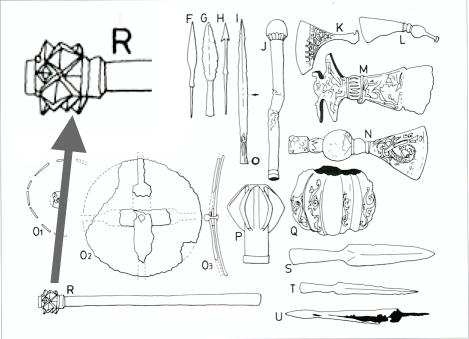
|
|
   |
 |
|
Dave Womble
Location: Laconia, NH USA Joined: 03 Feb 2006
Posts: 36
|
 Posted: Wed 01 Mar, 2006 3:05 am Post subject: Posted: Wed 01 Mar, 2006 3:05 am Post subject: |
 |
|
Cool site (though I can't read it!  ) and the images are impressive....however, those maces are dated to the 12th and 13th century...200-300 years after the academically, historically and generally accepted end of the Viking Age. Plus they are all essentially Russian. The Rus were much more Slavic and Russian than they were Scandinavian vikings. ) and the images are impressive....however, those maces are dated to the 12th and 13th century...200-300 years after the academically, historically and generally accepted end of the Viking Age. Plus they are all essentially Russian. The Rus were much more Slavic and Russian than they were Scandinavian vikings.
So, more support for the statement: No viking maces.
Dave
"Violence might not be the answer, but it sure cuts down on the number of questions."
|
|
    |
 |
|
J. Bedell
|
 Posted: Thu 02 Mar, 2006 4:01 am Post subject: Posted: Thu 02 Mar, 2006 4:01 am Post subject: |
 |
|
So we pretty much confirmed that as far as we know there were no viking maces. If this is the case than why does the Bayeaux Tapestry show a mace being thrown? Well I was thinking about it and came up with a intersting speculation. This thought may be way off track but here it goes.
Maybe the mace in the tapestry is symbolic and doesn't literally mean that a mace is being thrown. If a mace was thrown I doubt it would be important enough to put this one exception into the tapestry. Could it be that the mace(a symbol of status/power) is symbolic of the Norman knights gaining the status and power of the English lords? Or am I giving the makers of the tapestry too much credit for their wit?
just a thought....
-james
|
|
    |
 |
|
Dave Womble
Location: Laconia, NH USA Joined: 03 Feb 2006
Posts: 36
|
 Posted: Thu 02 Mar, 2006 11:39 am Post subject: Posted: Thu 02 Mar, 2006 11:39 am Post subject: |
 |
|
Interesting suggestion. We'll never know for sure.
The mace that's being thrown isn't being thrown by a viking, so I don't see how we can use that imagery to validate the existance of viking maces.
How do we know that the mace in question isn't being thrown to demonstrate some other aspect besides combat? We know maces were status symbols more than weapons...at least at that point in time....perhaps the owner received a mortal or near fatal wound that caused him to relinquish it. Perhaps it was a signal to attack? A lone mace cast in a battle is hardly note worthy if all it was, was another random missile being flung at the enemy. I prefer to regard a mace in that scenario as more like a baton or sceptre, and not a weapon.
Dave
"Violence might not be the answer, but it sure cuts down on the number of questions."
|
|
    |
 |
Merv Cannon

|
 Posted: Sun 05 Mar, 2006 2:09 am Post subject: Maces- viking or otherwise Posted: Sun 05 Mar, 2006 2:09 am Post subject: Maces- viking or otherwise |
 |
|
Ok then ...........lets forget the concept of "Viking" maces.........lets call them ...."Later Period post - Viking and Rus knobby things on a stick ".
I found a photo of some (much) later "knobby things on a stick" .( lets, for lack of a better term use "psuedo-maces", cause its a lot quicker to spell.) ....that belong to the Polish dudes. I only post it here because they bare an interresting ( to me ) resemblance to the "knobbies" in the other posted photos, ie. being particularly small and knobby ( and, on a stick ! ) and also round with small flutes. There is also a bronze one too. Probably just a symbol of authority, even though our encyclopedic ex-museum group leader assures me they can do a lot more damage than just crackin' walnuts after the battle.
 Attachment: 19.29 KB Attachment: 19.29 KB
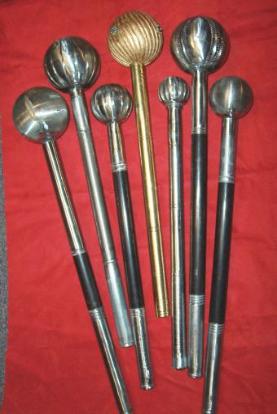
|
|
   |
 |
|
J. Bedell
|
 Posted: Sun 05 Mar, 2006 8:24 am Post subject: Posted: Sun 05 Mar, 2006 8:24 am Post subject: |
 |
|
Those are very nice pieces. Although they are status symbols mostly, i wouldn't mind carrying one into battle. They look like they could do some damage. 
Just imagine the look on your poor enemies face (before you smash it that is)....... 
|
|
    |
 |
|
Felix Wang
|
 Posted: Mon 06 Mar, 2006 1:09 pm Post subject: Posted: Mon 06 Mar, 2006 1:09 pm Post subject: |
 |
|
|
I suspect these Eastern European maces owe a lot more to Middle Eastern and Steppe warfare than to anything Viking. There was a long and distinguished tradition of maces in Persia and Central Asia, where they never went out of fashion. See: http://www.rozanehmagazine.com/MarchApril06/A...ucher.html (towards the end) This included ball headed maces like the Polish ones shown above.
|
|
  |
 |
Merv Cannon

|
 Posted: Mon 06 Mar, 2006 3:34 pm Post subject: Polish or Hungarian Mace Posted: Mon 06 Mar, 2006 3:34 pm Post subject: Polish or Hungarian Mace |
 |
|
Well.....What ever influenced their development it's obvious that these smaller round often bronze maces were used for warfare somewhere along the line......I found another fine example for those that have an interrest......
 Attachment: 122.86 KB Attachment: 122.86 KB
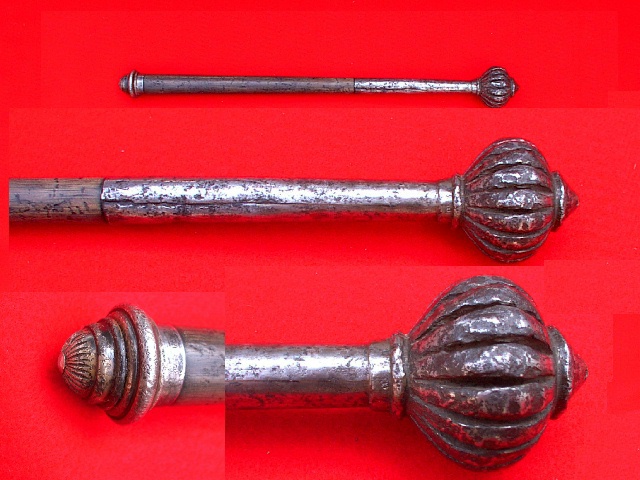
|
|
   |
 |
|
Danny Grigg
|
 Posted: Tue 07 Mar, 2006 4:34 am Post subject: Posted: Tue 07 Mar, 2006 4:34 am Post subject: |
 |
|
I believe these rounded / pear shaped maces are called Bulawa / Bulava or the Turkish Topus / Topuz
From The Complete Encyclopedia of Arms and Weapons Edited by Leonid Tarassuk & Claude Blair
Bulawa
A mace with a globular or pear-shaped head, known for centuries in many Oriental and Eastern European countries such as India, Persia, Turkey, Russia, Hungary, and Poland (where the word "Bulawa" originated). It also made sporadic appearances in western Europe.
In ancient Egypt and Mesopotamia, the mace of similar forms was regarded as a symbol of rank in the hands of the Pharaohs and Kings. It was also used as a votive offering, when it would have had a simple stone or clay head. Although it was used as a war club, it remained chiefly a token of military rank or sovereignty and would have been given, for example, to the Transylvanian Princes or Walachian Hospodars. In Poland, Russia and the Ukraine it denoted the office of hetman or commander-in-chief of the army.
The Turkish war Bulawa (Topus) was usually made of steel. A symbolic one, however, was made with a decorative head of some precious metal or of rock crystal, horn or ivory and according to the material used, chased, gilded, nielloed, or encrusted with gems. The wooden handle was covered with decorated metal and sometimes concealed a stylus.
http://otlichnik.tripod.com/medmace4.html
http://claudiospage.com/streitko.htm
http://www.knife.cz/noziri/andrysek/
http://www.tuerkenbeute.de/sam/sam_hoh/G37_de.php
http://www.tuerkenbeute.de/sam/sam_hoh/D242_de.php
http://www.turkishculture.org/weapons/mace.html
http://www.lviv.uar.net/~lhm/bulava.htm
http://uk.wikipedia.org/wiki/%D0%97%D0%BE%D0%...Bulava.jpg
http://oldarsenal.com/Polish%20%20or%20Hungar...entury.htm
http://www.hermann-historica.de/auktion/hhm48...at48_1.txt
http://www.hermann-historica.de/auktion/hhm49...at49_A.txt
http://www.hermann-historica.de/auktion/hhm49...at49_A.txt
|
|
  |
 |
|
Adam Daubney
Location: England Joined: 23 Nov 2005
Posts: 5
|
 Posted: Thu 09 Mar, 2006 3:13 am Post subject: Posted: Thu 09 Mar, 2006 3:13 am Post subject: |
 |
|
Hi,
Going back to the original post here....
The photograph of the mace head is nearly identical to one found in a grave in Gotland. It is published in:
Thunmark-Nylen, Lene, 1998, Die Wikingerzeit Gotlands, II, Typentafeln. Stockholm, tafel 264 no. 2 and 3.
Hope this helps,
Adam
|
|
   |
 |
Merv Cannon

|
 Posted: Thu 09 Mar, 2006 4:56 am Post subject: Early Norman Mace Head. Posted: Thu 09 Mar, 2006 4:56 am Post subject: Early Norman Mace Head. |
 |
|
Thanks Adam....thats cool.....Well whatever they were used for .....combat or rank , they are interresting .......there are so many unanswered questions about arms and armour. On the subject of maces...I found this illustration of an early Norman Mace head. Many would be familiar with it I'm sure.........but it is also interresting as it looks like a big sword pommel...
I wonder if anyone else had museum photos or drawings of these or any other unusual maces ?
 Attachment: 33.97 KB Attachment: 33.97 KB
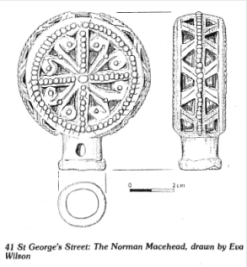
|
|
   |
 |
|
Adam Daubney
Location: England Joined: 23 Nov 2005
Posts: 5
|
 Posted: Thu 09 Mar, 2006 9:02 am Post subject: Posted: Thu 09 Mar, 2006 9:02 am Post subject: |
 |
|
We have recorded a few of these from England now on our database www.finds.org.uk
I think they are similar in function to the more decorative mace heads we see in places such as Denmark and Ireland, however the archaeological layers that the openwork 'pommels' are found in are actually earlier than the cruder mace heads. I've seen one 'pommel' that has a small stone pea in the middle of it, suggesting that it could have been used as a rattle (religious) or as an incence stick.
The copper alloy mace heads you are referring to have been found with wooden handles before, although the thinness of them suggests they weren't very good for thrashing your enemies. One unusual macehead from Soberg actually had an iron spike at the top.
Adam
|
|
   |
 |
Merv Cannon

|
 Posted: Thu 16 Mar, 2006 5:22 am Post subject: Rus and Eastern Maces Posted: Thu 16 Mar, 2006 5:22 am Post subject: Rus and Eastern Maces |
 |
|
Further to this saga about small headed maces, I have requested information from another (Polish) arms maker here in Oz namely Nick from "Bloodbeak Armouries". Nick has made some great products which are for sale on his web-site including some very nice Rus Sabers ! However, I am posting his very informative reply as it contains some great information which might be useful for those that are interrested.....
"Maces were used during the Viking period, though not by Vikings themselves as far as I know. ( apart from the Rus who definitely came into contact with them). Maces were being used on the Russian steppes and Middle East as a weapon and also as a status symbol. My earliest sources for maces are from the Khazars (7th-10th c) who were using two types of maces. A normal metallic head mace on a shaft and the so called "flight-mace". The head of the mace being connected to the shaft either by strapping or chain. It is suggested that these weapons were thrown at an opponent to either stun or confuse him. These maces were made from a variety of metals iron, bronze and lead sometimes horn. More common on the steppes was the Chekan, a cavalry axe which resembles later European war picks. Some people argue that weapons such as the mace and the Chekan became more popular due to the ineffectiveness of sabres and Pallashes against armour. Sabres are great cutting weapons and are devastating against unarmoured foes but quite useless against armours such as mail or lammellar. So weapons such as Chekans and maces evolved as close combat weapons, being much more effective in causing injury to armoured opponents ie- blunt trauma. Another early source I have for a mace-like weapon is from the middle eastern early Abbasid period. Two types again are known , the Dabbus or common type mace with wooden shaft and metallic head, and the Amud which was a solid metallic baton. The Amud was nothing more than a solid rod of iron, considerably long and heavy. The largest of these weapons were called al-Mustafwi measuring about 100cm (2 Iraqi cubits) A blow from the Amud was certainly always fatal and was used much like a viking sword… ie the bearer always picked his strokes and made sure each stroke was a killing one. Due to the weight cumbersome nature of this weapon it fell out of use. The Amud also was a very costly weapon, and was exclusively used only by the Caliph or by army commanders so in fact it was a status symbol though a very handy one. There are more references to maces from the east, but I would be here forever! As far as western sources for maces during the viking period I don’t really have one. The earliest source I have is the Bayeaux tapestry where maces are shown flying in mid air ! But this is getting very late and the advantage of raiding and hit and run tactics of the vikings has ended. I’ve attached some pics. The pic with all the weapons shows early Khazar flight-maces ( they look like grenades). For a good read where most of this info came from get “The Companion to Medieval Arms and Armour” by David Nicole, The Boydell press, 2002. ISBN - 0 85115 872 2
http://www.bloodbeak.com/other.html
 Attachment: 14.39 KB Attachment: 14.39 KB
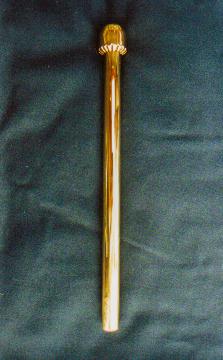
 Attachment: 39.02 KB Attachment: 39.02 KB
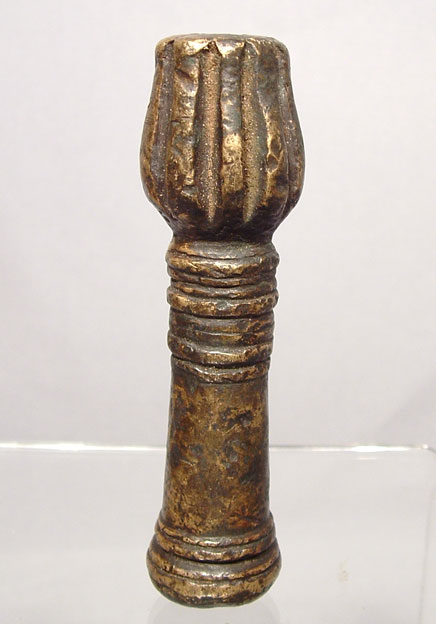
 Attachment: 35.21 KB Attachment: 35.21 KB
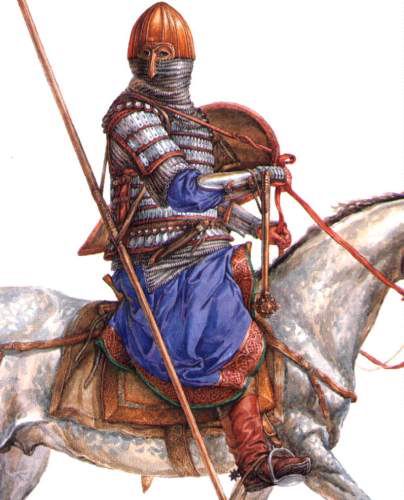
 Attachment: 45.06 KB Attachment: 45.06 KB
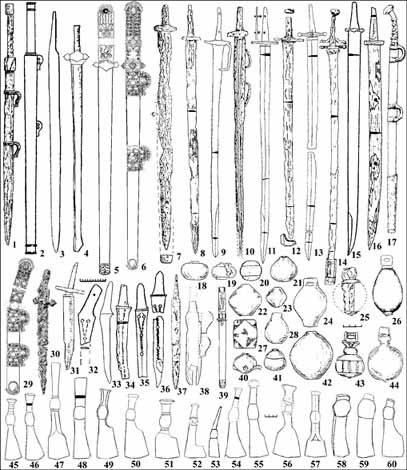
 Attachment: 60.67 KB Attachment: 60.67 KB
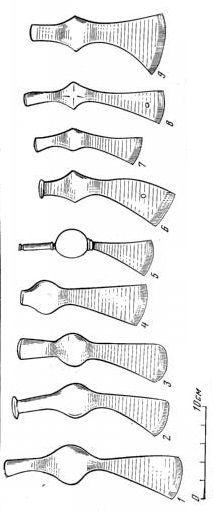
 Attachment: 42.33 KB Attachment: 42.33 KB
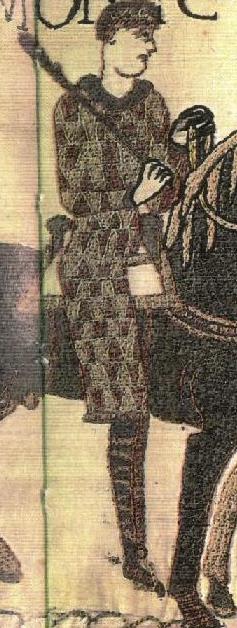
|
|
   |
 |
Matthew D M

Location: SouthEast Texas Joined: 04 Aug 2004
Posts: 63
|
 Posted: Thu 16 Mar, 2006 1:07 pm Post subject: Posted: Thu 16 Mar, 2006 1:07 pm Post subject: |
 |
|
|
Looks like a scepter head to me.
|
|
  |
 |
|
Dave Womble
Location: Laconia, NH USA Joined: 03 Feb 2006
Posts: 36
|
 Posted: Thu 16 Mar, 2006 4:30 pm Post subject: Posted: Thu 16 Mar, 2006 4:30 pm Post subject: |
 |
|
Flight-mace? shaft w/ a head connected by chain or strap? Yeah...it's called a flail.
Another agricultural tool (for threshing grain) modified into use as a weapon. Not a weapon you'd find in the hands of any cultures warrior elite in most cases.
The other bits were interesting though, thank you for sharing his reply to you. I believe the garrison at Birka at one point housed a Khazar force. They may have had a mace or two hanging around.
I would expect to find maces more prolific amongst cultures that relied more on cavalry...even a small headed mace can deliver devastating trauma to even an armoured opponent from horseback at a canter or gallop.
One thing I was always curious about (I may have already said this) was the fact hammers as weapons didnt figure more prominently (or should I say rather *at all*) in Norse culture. Especially given the fact one of their chief deities (Thor) wielded one, and also given the fact hammers of various sizes and types were used in the forge and in shipbuilding, 2 important and elite crafts of the Viking Age.
Of course, armour was a rare and expensive commodity, so it wouldnt have been the norm to face heavily armoured foes where a mass weapon like a hammer or mace would be more suited. Cutting and stabbing weapons were more practical.
Would still be pretty slick to find a hammer decorated in similar fashion to the Mammen axe. 
Dave
"Violence might not be the answer, but it sure cuts down on the number of questions."
|
|
    |
 |
Nick Trueman

|
 Posted: Mon 27 Mar, 2006 11:32 pm Post subject: Posted: Mon 27 Mar, 2006 11:32 pm Post subject: |
 |
|
Flight-mace? shaft w/ a head connected by chain or strap? Yeah...it's called a flail.
In this case it is called a flight mace. Khazars armies where made up primarily of cavalry. I do not dought that the weapon was probably developed from a agricultural tool, though its use on horseback leaves only one or two options?
Flails , flight mace, there is no rite name just differant time period and use.
N
|
|
  |
 |
|
Ladoga S
Location: United Kingdom Joined: 25 Mar 2007
Posts: 16
|
 Posted: Tue 27 Mar, 2007 12:42 am Post subject: Posted: Tue 27 Mar, 2007 12:42 am Post subject: |
 |
|
|
Merv but almost all your examples here are minimum 12/13 century. In all russian graveyards or khurhans connected with Russ culture (Swedish Viking Traders or Settlers) i never meet any example of this kind of mace. Even picture with horse rider ( author Oleg Fiedorov) in poly-lihina ( half-mask) is 13 century
|
|
  |
 |
Nick Trueman

|
 Posted: Wed 28 Mar, 2007 7:43 am Post subject: Posted: Wed 28 Mar, 2007 7:43 am Post subject: |
 |
|
L
The maces in the BW pic are early Khazar flight maces 8th-9thc, the czekans are from 8th c onwards. The illustrations as you have stated are 12-13th c. The connection being that early Rus traders were in contact with Khazar/Magyar peoples and copied and developed there particular style of weaponry and style of clothing from this contact. There is no question that the maces illustrated in the drawings are not from the viking age.
Cheers
N
|
|
  |
 |
|
Felix Wang
|
 Posted: Wed 28 Mar, 2007 9:25 pm Post subject: Posted: Wed 28 Mar, 2007 9:25 pm Post subject: |
 |
|
It should be mentioned that the Byzantine cataphracts also used maces, at least in the 9th to 10th centuries. Nikephoros Phokas specifies their use by the elite, heaviest armoured cataphracts, and a picture of a mace is shown here:
 Attachment: 68.15 KB Attachment: 68.15 KB
[ Download ]
|
|
  |
 |
|
Ladoga S
Location: United Kingdom Joined: 25 Mar 2007
Posts: 16
|
 Posted: Thu 29 Mar, 2007 12:35 am Post subject: Posted: Thu 29 Mar, 2007 12:35 am Post subject: |
 |
|
Nick about the mace. Ofcourse connection with Khazars and other nomads, was quite strong during Viking Expansion times, but maces above its min 11c (for me min.12c) Here is some examples for you
 Attachment: 122.71 KB Attachment: 122.71 KB
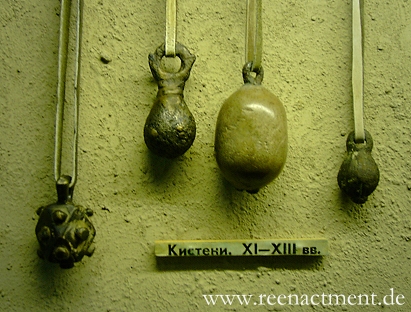
 Attachment: 123.33 KB Attachment: 123.33 KB
[ Download ]
|
|
  |
 |
|
|

